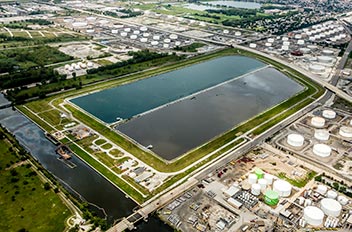CDF Dike Expansion

The exterior dikes of the Indiana Harbor and Canal (IHC) confined disposal facility (CDF) were expanded to increase storage capacity.
Dredging and disposal of dredged material to the CDF began in 2012. Through 2020, the backlog volume of approximately 1.7 million cubic yards of dredged material was placed into the CDF. At that time, the CDF included two interior cells separated by a center dike that is approximately 14 to 16 feet high surrounded by exterior dikes that were approximately 20 feet high. Consistent with the original project authorization and plan, the US Army Corps of Engineers (USACE) expanded the CDF exterior dikes (designated Phase 2 dike project) by 11 feet to maintain sufficient storage capacity for the intended project life.
Scope
The dike expansion included reconfiguring access ramps; replacing utilities, outlets, piezometers, and roads; adding seepage control and an emergency overtopping area; adding venting for methane at one location; and other related work to extend the containment dikes vertically. The construction of the dike expansion ensures that a proper disposal facility is available for IHC sediment for many years to come.
Schedule
The 11-foot dike expansion occurred from July 2021 through June 2024. No dredging and dredged material placement occurred during the dike expansion. CDF operational activities such as groundwater extraction and water treatment continued during dike expansion.
Air Quality Impacts During and After Construction
The CDF dike expansion had an insignificant impact on air quality since the dike was constructed with clean material, and the contents of the CDF were not disturbed during construction.
During the dike construction period, air monitoring equipment from the existing pads on top of the dikes were moved to temporary gravel pads in the northeast corner, southeast corner, and southwest corner of the site. Air monitoring during the dike construction period included:
- Real-time particulate monitors at the northeast and southeast temporary pads
- Ambient air/high volume air samplers at the southwest temporary pad (PAHs, PCBs, BTEX/a few VOCs, metals, and total suspended particulates or TSP)
This monitoring is consistent with the single ambient air monitoring location on the site during CDF construction. The additional particulate monitoring supported the traditional visual dust monitoring conducted at construction sites. Throughout the period, the ambient air monitoring at the East Chicago High School continued.
After completion of the dike expansion, air monitoring equipment, except for the real-time naphthalene monitors as discussed below, were re-installed on top of the dikes, and the air monitoring program resumed.
Real-Time Naphthalene Monitoring

Four real-time naphthalene air monitors (UV-DOAS) operated continuously at the four corners of the CDF dikes since the spring of 2012.
These naphthalene units recorded data every 15 minutes. Average levels were computed for a 24-hour period and were compared to Action Levels. From 2012 to 2021:
- Approximately 0.1% of the records had a CDF contribution of naphthalene greater than zero.
- The maximum CDF contribution during this period is an instantaneous concentration of 183 ug/m3. There have been only two instantaneous naphthalene concentrations recorded above 150 ug/m3, but the 24-hour average levels never exceeded either Action Level.
The levels of naphthalene and other chemicals of concern in the IHC sediments have decreased significantly in the last several decades. These levels are expected to continue to decrease in the future due to legacy contaminated material being removed by dredging, regulation of uncontrolled discharges, improved sewage systems, and changes in land use practices. Since naphthalene has been infrequently detected at the onsite real-time air monitors, the anticipated lower future concentrations of naphthalene in the sediment are expected to result in even fewer detections by the real-time naphthalene air monitors.
For these reasons, USACE stopped operating the real-time naphthalene air monitors when the dike expansion began, and it did not restart when dike construction was completed.
Real-time particulate air monitoring, and ambient air/high volume air monitoring continued through the dike construction/interim dike period at temporary locations off the dikes. When dike construction was completed, they were re-installed on top of the dikes and monitoring at those locations resumed.
See the Photo Gallery for photos of the dike expansion activities.

